The Rise and Fall Rare (Part 1)
From smalltown game developer, we look at the beginnings of the once Great British game studio.
Many notable cult game developers tend to rise and fall in the turn of the yesteryears. For every (BLIZZARD ENTERTAINMENT), (INSOMNIAC GAMES), or (NAUGHTY DOG, Inc). Game Studios that started as underdogs in decades past, and have since gone on to be top notch development houses of the modern industry.
There is always going to be a (Shiny ENTERTAINMENT), (CORE Design), or (Westwood STUDIOS). Game studios that at one point in time were on equal playing fields with the former, But somewhere down the line lost their way and went under. Either due to lack of creativity, lack of innovation, a changing business environment, financial problems, or other reasons entirely.

(RARE) definitely falls into the ladder. While even though technical there still around there’s no denying that at one time they were the greatest game developer to come out of the UK. But somewhere after the (MICROSOFT) buyout they lost their way, and have since fallen from grace and the interest of the public. In this series of articles I’m going to discuss the history Rare From there humble beginnings, to their Golden years, and inevitable decline.

Now to truly understand why RARE was so great to begin with we have to go all the way back to the very beginning. 1982 to be precise, the year the UK was introduced to the (ZX Spectrum). Now if you weren’t born yet or didn’t live in the UK during the early 80’s your probably wondering what’s a ZX Spectrum? It was part of a line of home computers released by (Sinclair Research Ltd) between 1982 and 1992. It was famous not only for being Britain’s first COLORED computer, but also its most affordable home computer. Though it is mostly remembered for its vast game library, and gaming community.
But what really gave the Spectrum its identity was it was very easy to program and develop games for. As a matter of fact home brewing was almost encouraged by the creators Sinclair as it not only brought forth some of the greatest games on the Spectrum. But also would become a jumping point where young programmers would later move on be game developers themselves someday, but I’m getting off track. Now that same year and long before RARE was RARE they were actually a small startup company in (Ashby, Leicestershire, England) called (ULTIMATE PLAY THE GAME).

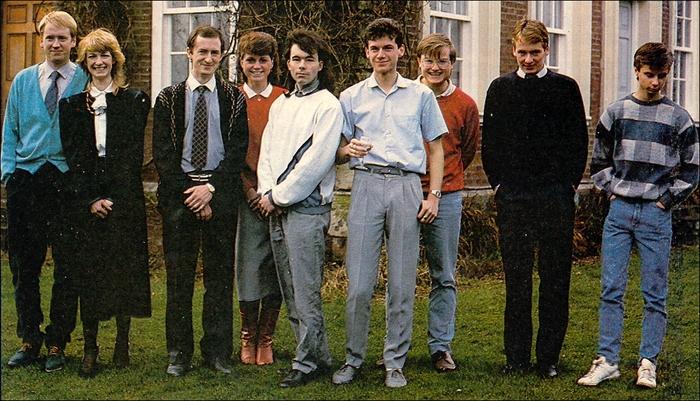
Prior to founding ULTIMATE, Chris Stamper the Older brother and graduate of Loughborough University worked for a company called (Associated Leisure) in 1979. There Job was to convert Japanese and American Arcade Cabinets for the British Market and also provide technical assistance and repair work for Arcade Owners at the time. He was also able to find work for his younger and less technical brother Tim.
In 1982 With three years of experience under there belts they decided to Create there own company with several of there new business partners, including Carole Ward (who would become company Secretary and Later Tim's wife) and in 1983 the following year they founded there company they would dazzle the UK with their very first game, a little known title called (Jetpac).

Jetpac is often famous among RARE enthusiasts as there very first game, and rightfully so as every company’s first games marks the beginning of a special and great journey into a bigger world.


The gameplay consisted of controlling an astronaut with a jetpac across various alien planets where you have to rebuild your spaceship, and collect fuel to blast off. You also had to use your laser to defend yourself from various aliens or natural hazards that drift across the level, and there are extra items you could collect to earn points. There were a total of four different spaceships you could assemble across the game and each planet had a different type of alien or natural hazard that would attack you. For Ultimate’s first game they showed that they offer both variety and challenge. Two things we would come to expect from them as we would come to know them as RARE.

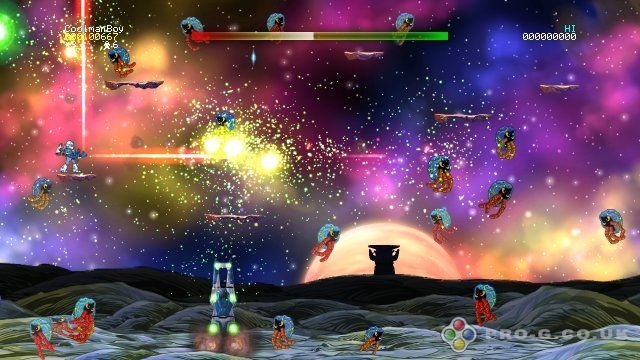
Jetpac would later become an unlockable extra in 1999's(DONKEY KONG64), and would be remade for (XBOX LIVE ARCADE) in 2007's(JETPAC REFUELLED) but that's a story for another day.
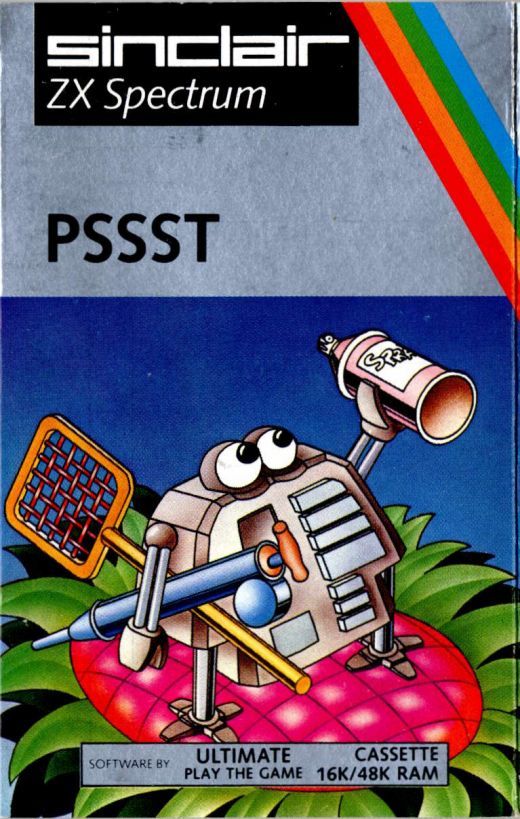
In (Pssst) you were essentially a Robot who had to keep bugs away from a giant sunflower with a can of spray as it grew to the top and when it blossomed you were rewarded with a ton of points, as you can guess if the bugs ate your plant it was game over. You also could pick up different colored spray cans with different effects.

Not a whole lot more to say, many games from this era used this simple arcade style of gameplay but this was still the early years of gaming after all.


(Trans Am) is ULTIMATE'S first Vehicle driving game, years before (Blast Corps) and (R.C. Pro-Am). The setting is a post apocalypse wasteland (ala Mad Max) where you drive a vehicle from an overhead perspective around a free roaming over world collecting gasoline and trophies while avoiding enemy vehicles and obstacles.
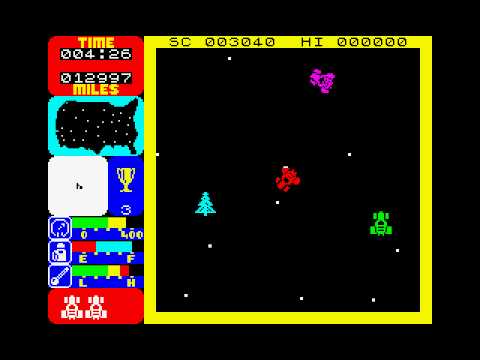
What makes this one interesting is this is probably the first post apocalypse video game that lets you drive a vehicle, years before games like (Battletanx), (Rogue Trip: Vacation 2012), and (Carmageddon), I shouldn’t even have to mention the awful NES Mad Max.


In (Cookie) you control a cartoonish looking chief character that shoots bags of flower as ammunition. The objective is to shoot all the ingredients needed to bake cookies into the mixing bowl without shooting in rotten ingredients or inedible objects. You also cannot touch anything that moves or you’ll die.


A sequel to Jetpac which technically makes this Ultimate’s first video game
series.

While the gameplay of flying around with a jetpac and shooting your laser is still intact, the main gimmick this time around is that you can now drive a moon rover. It’s a lot slower then flying but the purpose is to carry time bombs toward alien bases on the moon’s surface to blow them up.

There his however uneven terrain your rover cant traverse which requires you to step out to make a sort of makeshift bridge. The aliens will also try to destroy your vehicle with missiles that you’ll have to fly out and destroy. Airborne hazards from Jetpac also make their return.

To best describe the gameplay of (Atic Atac). It plays very much like the dungeon segments of (Zelda), though it actually predates the first Zelda by 3 years.

You’re a knight trying to escape a haunted castle, the game is viewed from an overhead perspective and you can travel into different rooms in a non-linear fashion. Your defense from the many spawning monsters is a flying axe. You can also find keys that unlock different doors and other useful items. However you can only hold three items at a time. Your life bar is depicted as a roast turkey that will run down if you don’t find more food to eat.
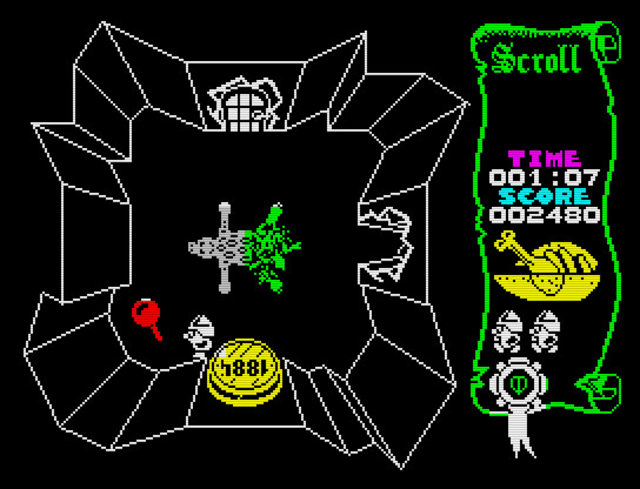
When you think about it Atic Atac was a game pretty far ahead of its time, especially when you consider it did a lot of what Zelda would later do. Though it is worth noting that these ideas could also be traced back to the (Atari 2600) game (Adventure) from 1979, which gave the Stamper Bros a lot idea’s for Atic Atac. The wonders of the gaming industry is that ripping each other off often helps create exciting new video game genres.

In (Sabrewulf) you play as an Explorer simply named Sabreman. In this game you explore a massive jungle overworld designed like a maze in search of the four pieces of a mysterious wulf amulet. However the jungles wildlife, natives, as well as a blue wulf called Sabrewulf are out to kill you, and your only defense is your trusty sabre sword hence the name. With all the danger lurking about you had to find the amulet quickly and escape the jungle alive.

This would mark the beginning of ULTIMATE'S second iconic game series, the (Sabreman) series, and Sabreman would go on to appear in three more Spectrum games.
There is always going to be a (Shiny ENTERTAINMENT), (CORE Design), or (Westwood STUDIOS). Game studios that at one point in time were on equal playing fields with the former, But somewhere down the line lost their way and went under. Either due to lack of creativity, lack of innovation, a changing business environment, financial problems, or other reasons entirely.

(RARE) definitely falls into the ladder. While even though technical there still around there’s no denying that at one time they were the greatest game developer to come out of the UK. But somewhere after the (MICROSOFT) buyout they lost their way, and have since fallen from grace and the interest of the public. In this series of articles I’m going to discuss the history Rare From there humble beginnings, to their Golden years, and inevitable decline.
Part 1: the ZX Spectrum Years

Now to truly understand why RARE was so great to begin with we have to go all the way back to the very beginning. 1982 to be precise, the year the UK was introduced to the (ZX Spectrum). Now if you weren’t born yet or didn’t live in the UK during the early 80’s your probably wondering what’s a ZX Spectrum? It was part of a line of home computers released by (Sinclair Research Ltd) between 1982 and 1992. It was famous not only for being Britain’s first COLORED computer, but also its most affordable home computer. Though it is mostly remembered for its vast game library, and gaming community.
But what really gave the Spectrum its identity was it was very easy to program and develop games for. As a matter of fact home brewing was almost encouraged by the creators Sinclair as it not only brought forth some of the greatest games on the Spectrum. But also would become a jumping point where young programmers would later move on be game developers themselves someday, but I’m getting off track. Now that same year and long before RARE was RARE they were actually a small startup company in (Ashby, Leicestershire, England) called (ULTIMATE PLAY THE GAME).


The Founder's of ULTIMATE, from Left to Right.
Tim Stamper (Graphics Director), Carole Stamper (Company Secretary), Chris Stamper (Software Director), Rachel (Secretary), David (Sound / Music Department), Mark (Head Of Software), Paul (Software), Steve (Graphics) and Kevin (Graphics)
Prior to founding ULTIMATE, Chris Stamper the Older brother and graduate of Loughborough University worked for a company called (Associated Leisure) in 1979. There Job was to convert Japanese and American Arcade Cabinets for the British Market and also provide technical assistance and repair work for Arcade Owners at the time. He was also able to find work for his younger and less technical brother Tim.
In 1982 With three years of experience under there belts they decided to Create there own company with several of there new business partners, including Carole Ward (who would become company Secretary and Later Tim's wife) and in 1983 the following year they founded there company they would dazzle the UK with their very first game, a little known title called (Jetpac).
Jetpac (1983)

Jetpac is often famous among RARE enthusiasts as there very first game, and rightfully so as every company’s first games marks the beginning of a special and great journey into a bigger world.


The gameplay consisted of controlling an astronaut with a jetpac across various alien planets where you have to rebuild your spaceship, and collect fuel to blast off. You also had to use your laser to defend yourself from various aliens or natural hazards that drift across the level, and there are extra items you could collect to earn points. There were a total of four different spaceships you could assemble across the game and each planet had a different type of alien or natural hazard that would attack you. For Ultimate’s first game they showed that they offer both variety and challenge. Two things we would come to expect from them as we would come to know them as RARE.


Jetpac would later become an unlockable extra in 1999's(DONKEY KONG64), and would be remade for (XBOX LIVE ARCADE) in 2007's(JETPAC REFUELLED) but that's a story for another day.
Pssst (1983)

In (Pssst) you were essentially a Robot who had to keep bugs away from a giant sunflower with a can of spray as it grew to the top and when it blossomed you were rewarded with a ton of points, as you can guess if the bugs ate your plant it was game over. You also could pick up different colored spray cans with different effects.

Not a whole lot more to say, many games from this era used this simple arcade style of gameplay but this was still the early years of gaming after all.

Trans Am (1983)

(Trans Am) is ULTIMATE'S first Vehicle driving game, years before (Blast Corps) and (R.C. Pro-Am). The setting is a post apocalypse wasteland (ala Mad Max) where you drive a vehicle from an overhead perspective around a free roaming over world collecting gasoline and trophies while avoiding enemy vehicles and obstacles.

What makes this one interesting is this is probably the first post apocalypse video game that lets you drive a vehicle, years before games like (Battletanx), (Rogue Trip: Vacation 2012), and (Carmageddon), I shouldn’t even have to mention the awful NES Mad Max.

Cookie (1983)

In (Cookie) you control a cartoonish looking chief character that shoots bags of flower as ammunition. The objective is to shoot all the ingredients needed to bake cookies into the mixing bowl without shooting in rotten ingredients or inedible objects. You also cannot touch anything that moves or you’ll die.

Lunar Jetman (1983)

A sequel to Jetpac which technically makes this Ultimate’s first video game
series.

While the gameplay of flying around with a jetpac and shooting your laser is still intact, the main gimmick this time around is that you can now drive a moon rover. It’s a lot slower then flying but the purpose is to carry time bombs toward alien bases on the moon’s surface to blow them up.

There his however uneven terrain your rover cant traverse which requires you to step out to make a sort of makeshift bridge. The aliens will also try to destroy your vehicle with missiles that you’ll have to fly out and destroy. Airborne hazards from Jetpac also make their return.
Atic Atac (1983)

To best describe the gameplay of (Atic Atac). It plays very much like the dungeon segments of (Zelda), though it actually predates the first Zelda by 3 years.

You’re a knight trying to escape a haunted castle, the game is viewed from an overhead perspective and you can travel into different rooms in a non-linear fashion. Your defense from the many spawning monsters is a flying axe. You can also find keys that unlock different doors and other useful items. However you can only hold three items at a time. Your life bar is depicted as a roast turkey that will run down if you don’t find more food to eat.

When you think about it Atic Atac was a game pretty far ahead of its time, especially when you consider it did a lot of what Zelda would later do. Though it is worth noting that these ideas could also be traced back to the (Atari 2600) game (Adventure) from 1979, which gave the Stamper Bros a lot idea’s for Atic Atac. The wonders of the gaming industry is that ripping each other off often helps create exciting new video game genres.
Sabrewulf (1984)

In (Sabrewulf) you play as an Explorer simply named Sabreman. In this game you explore a massive jungle overworld designed like a maze in search of the four pieces of a mysterious wulf amulet. However the jungles wildlife, natives, as well as a blue wulf called Sabrewulf are out to kill you, and your only defense is your trusty sabre sword hence the name. With all the danger lurking about you had to find the amulet quickly and escape the jungle alive.

This would mark the beginning of ULTIMATE'S second iconic game series, the (Sabreman) series, and Sabreman would go on to appear in three more Spectrum games.

Years later, the 1994 fighting game (KillerInstinct) would feature a character in the Roster called Sabrewulf, an obvious reference to the old Spectrum game.

Sabreman would also make a cameo appearance years later in the 2000 N64 platformer (Banjo- -Tooie).
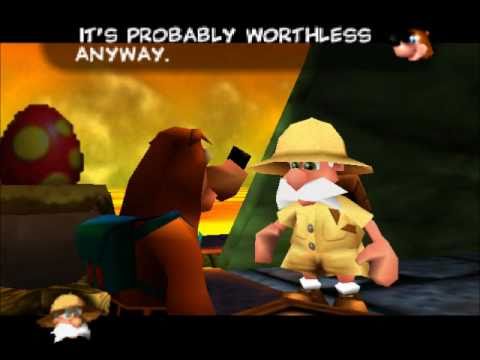
It's also worth noting that (Sabrewulf) was remade for the (Gameboy Advance) in 2004, but for the sake of time and consistency I'm going to exclude handheld games from this series of articles.

Underwurlde (1984)
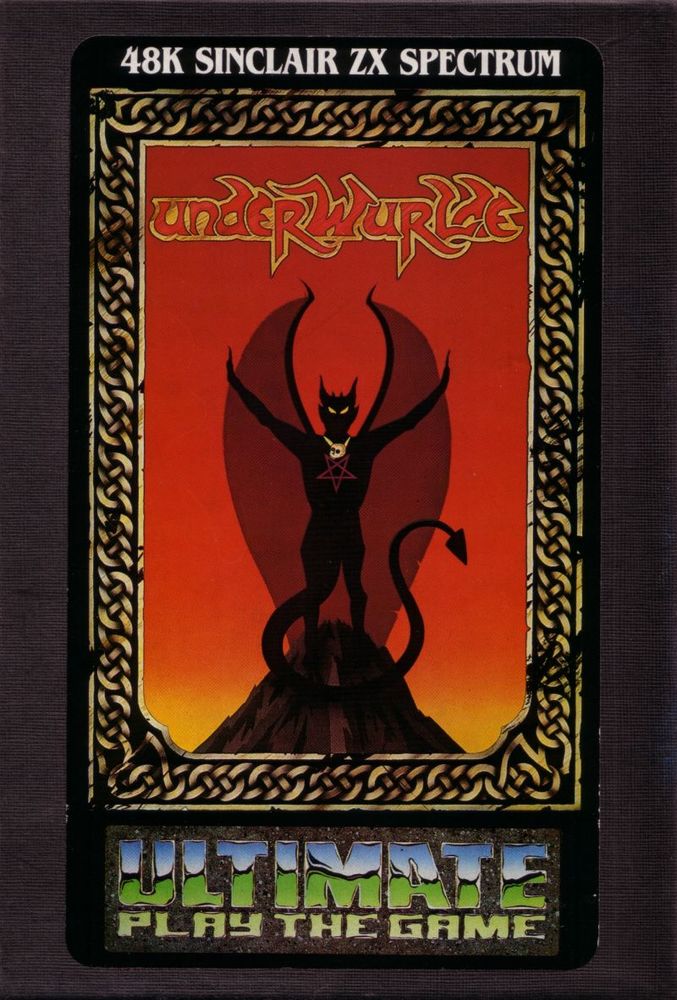
The Second game in the Sabreman Series, (Underwurlde) picks up exactly where Sabrewulf left off. After finding the wolf amulet and escaping the jungle through a cave Sabreman finds himself trapped in the underwurlde where he has to find a way to escape before the many dangerous monsters and demons try to each him, you must also fight one of the three guardians in order to access next part of the cavern.

One major difference you’ll notice from Sabrewulf which was an overhead exploration game is this one is a side scrolling platformer. You still have to explore maze like levels to find the exit but this game despite being a sequel plays quite differently from the first.

You start out with a week slingshot however you eventually find other weapons like a bow and arrow and a throwing dagger. There are also areas where you can descend from a hanging rope to traverse deeper chasms, adding to the danger of exploration feel these games try to create.
Knight Lore (1984)

The third game in the Sabreman series. (Knight Lore) features our British explorer in a strange haunted castle. Bitten by the Sabrewulf from the for mentioned game Sabreman is now affected by a werewolf curse that turns him into a wolf at night and back into a human by day (via the games Day and Night cycle.) you have 40 days and 40 nights to search the castle for the ingredients needed to reverse your curse and bring them to the Wizard Melkhior so he can brew an antidote or you’ll remain a Werewolf forever.

The gameplay is presented in a 3D isometric perspective which for the era this was made in was a really advanced effect (were talking Wolfenstein 3D advanced here) you could move in four directions including jumping, and you could explore the castles many rooms in a non-linier fashion. There were also many platforming puzzles in this game, as well as block pushing puzzles years before Zelda introduced it.

The differences between werewolf and human were mostly cosmetic though some enemies will only attack you as a werewolf and you can also jump higher as a werewolf. Knight Lore in retrospect is often regarded as one of the most influential games of the Spectrum era, and would go in to inspire similar knock offs of its isometric look.

Knight Lore’s setting of a human with a werewolf curse living in an ancient castle, and seeking a cure clearly paved a large part in influencing Sabrewulf from (KillerInstinct).
Alien 8 (1985)

Knight Lore would be the last original game ULTIMATE would create as its isometric gameplay was so advanced and popular for its time that they decided to recycle its gameplay for there final 4 games.

The overall gameplay in (Alien 8) is very much like Knight Lore, with the differences being largely cosmetic. Instead of a castle you’re on a spaceship, and instead of a werewolf you’re a maintenance robot, and finally the day and night cycle is replaced with a light year counter indicating how much longer you have to repair the ship before it crashes into the coming planet.

Not really much more to say, the amount of empty rooms on the ship and spacesuits hanging on the wall definitely gives the game an isolated feel much like watching the 1979 scifi film (Alien), and controlling a tiny maintenance robot on a large ship also adds a flavor from the 1972 film (Silent Running).
Nightshade (1985)

In (Nightshade) you’re a Knight who’s exploring a plagued village filled with monsters and other horrors. But the main objective is to slay the four bosses displayed at the bottom of the screen with special items found throughout the village; the item needed to kill each boss also glows as you get closer to each one.

What makes it stand out from Knight Lore and Alien 8 is that instead of exploring individual rooms with a fixed camera you now have a free scrolling camera wherever you character moves, whether it is on the streets or inside the buildings. So in a sense this game was sort of like (Diablo) years before there was a Diablo.
Gunfright (1985)

(Gunfright) essentially used the same free scrolling isometric engine that Nightshade used, only replacing the plagued medieval village with the Wild West. This time you’re a Sheriff who has to travel around a frontier town to hunt down outlaws.
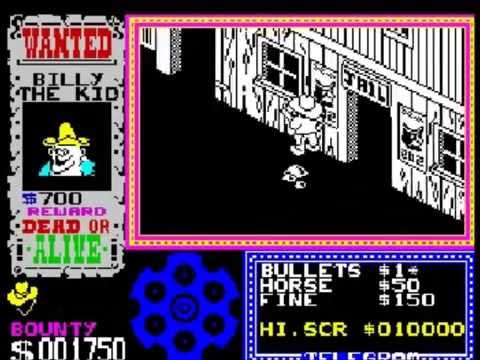
Once found you’d engage in a gun dual displayed in a first person view if you successfully gun him down then you claim his bounty and move onto the next outlaw, and you’d need that money to buy more bullets, rent horses to chase after other outlaws, and pay fines for shooting pedestrians.
Pentagram (1986)

This would be the Last Spectrum game ULTIMATE would ever make, and the last game in the Sabreman series. This time around Sabreman who’s now dressed like a wizard has to explore a creepy forest to find a lost magical Pentagram, and he can now shoot magic to defend himself.
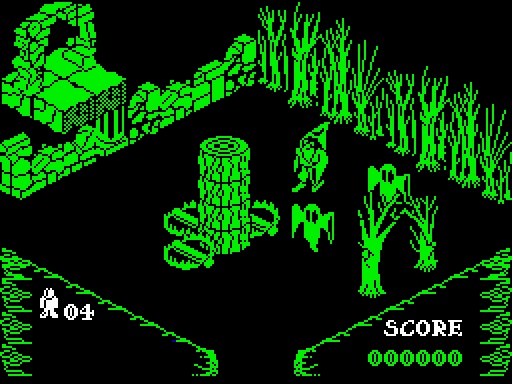
The main drawback this time is instead of using the free roaming engine that Nightshade and Gunfright used this one just goes back to the Knightlore and Alien 8 engine of having fixed rooms, and if you played the ladder two games you should already know what the gameplay is by now.

By this time it pretty much felt like they were just reskinning the same game over and over again, and considering this came out a year after Nightshade and Gunfright we expected better. There’s really not much Pentagram does to recommend it on its own merits.
Mire Mare (cancelled)[/u][/b]

It's worth noting there was to be one final Sabreman game called (Mire Mare) which was teased at the end of Knight Lore, and Pentagram. Supposably the game was finished but never released for reasons unknown, it's unknown if the game even still exists at this point.
Since there's no information about this game it's unknown if it would have just been the Knight Lore, Alien 8, and Pentagram gameplay, or the Nightshade, and Gunfright gameplay, or something else entirely.
In Closing
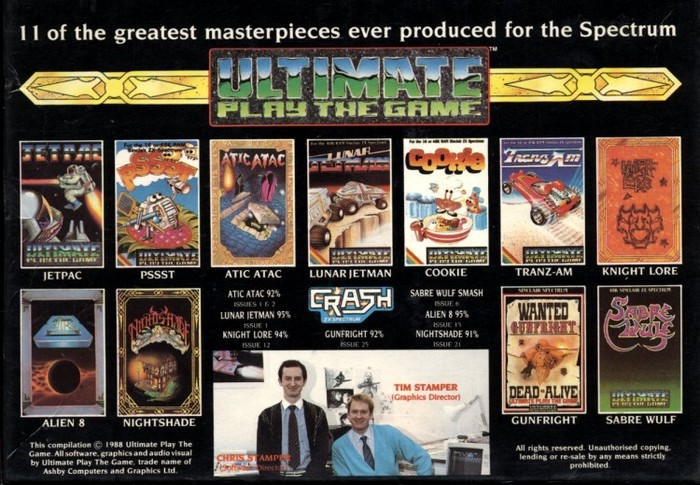
By 1986ULTIMATE PLAY THE GAME was the #1 ZX Spectrum Developer in the UK. They had single handedly pushed the computer’s limited hardware to its limits, and set the bar high for other Spectrum Developers to imitate and do better.
But now that ULTIMATE was a rising star with a vast treasure trove of programming knowledge, the real question is where do they go from here. What brave new frontiers do they now cross in what was, a still growing industry?
To be Continued in
Part Two: The NES years

8
Login To Vote!











Comments
7